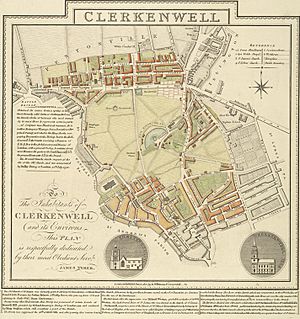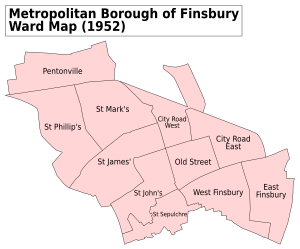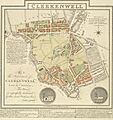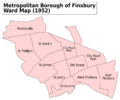Clerkenwell facts for kids
Quick facts for kids Clerkenwell |
|
|---|---|
 Clerkenwell Green and St James's Church |
|
| Population | 11,490 (2011 Census. Ward) |
| OS grid reference | TQ315825 |
| London borough | |
| Ceremonial county | Greater London |
| Region | |
| Country | England |
| Sovereign state | United Kingdom |
| Post town | LONDON |
| Postcode district | EC1 |
| Postcode district | WC1 |
| Dialling code | 020 |
| Police | Metropolitan |
| Fire | London |
| Ambulance | London |
| EU Parliament | London |
| UK Parliament |
|
| London Assembly |
|
Clerkenwell (/ˈklɑːrkənwɛl/) is a historic area in central London, England.
Clerkenwell has been an important place since the Middle Ages. Today, it is part of the London Borough of Islington. The church of St James and Clerkenwell Green are at the heart of the area.
Located near the City of London, Clerkenwell was once home to the Priory of St John. It also had many wells and spas, like Sadlers Wells. The special well that gave the area its name was found again in 1924.
Much of the land in Clerkenwell used to belong to the Marquess of Northampton. You can still see his family's influence in street names like Northampton Square, Spencer Street, and Compton Street.
In the past, making and fixing watches was a very important job here, especially around Northampton Square. In the 1900s, Clerkenwell became known as a hub for architecture and design.
Clerkenwell is home to City University and the Royal Mail's Mount Pleasant sorting office. It also includes the areas of Farringdon and Exmouth Market.
Contents
History of Clerkenwell
The Clerks' Well
Clerkenwell gets its name from the Clerks' Well on Farringdon Lane. In the Middle Ages, London's church clerks performed special plays based on Bible stories there every year.
Part of the well can still be seen today. It's built into a building called Well Court from the 1980s. You can look through a window on Farringdon Lane to see it. If you want to visit the well, you can arrange a trip with the Islington Local History Centre.
Old Monasteries
The Knights Hospitallers of St John of Jerusalem had their main English base at the Priory of Clerkenwell. This group was founded to help people during the Crusades.
St John's Gate, built in 1504, is a surviving part of the Priory Gate. After monasteries were closed down, this gateway was used for many different things. For example, the Gentleman's Magazine started here in 1731.
In the early 1900s, the gatehouse became linked with the Order again. It was the headquarters for the St John Ambulance Association. A very old crypt (an underground room) remains beneath the chapel, which was mostly rebuilt after being bombed in the 1950s.
Next to the priory was St Mary's nunnery, which has now disappeared. St James's Church was rebuilt in 1792 on the site of an older church. The London Charterhouse, near the City of London, was originally a Carthusian monastery. After the monasteries closed, it became a private home. Later, it became a school and a place for poor people to live. The almshouse (for the poor) is still there, but the school moved away.
A Popular Place to Live
In the 1600s, South Clerkenwell became a fashionable place to live. Oliver Cromwell, a famous English leader, owned a house on Clerkenwell Close. Many important people, like the Duke of Northumberland, also lived here.
Before Clerkenwell became a busy city area, it was a popular spot for Londoners to relax. They would visit its spas, which had natural springs, and enjoy tea gardens and theatres. The famous Sadler's Wells is still here today. It has been rebuilt many times and is now a leading theatre for modern dance.
Prisons in Clerkenwell
Clerkenwell was also home to three prisons: the Clerkenwell Bridewell, Coldbath Fields Prison, and the New Prison. The New Prison later became the Clerkenwell House of Detention.
In 1867, there was a famous event called the Clerkenwell Outrage. This was an attempt to break prisoners out of the House of Detention by blowing up a wall. The explosion caused a lot of damage and hurt many people nearby. The House of Detention was torn down in 1890. However, its underground vaults and cells, known as the Clerkenwell Catacombs, still exist. They were used as air-raid shelters during World War II and have been used for filming movies.
Industrial Changes
The Industrial Revolution brought big changes to Clerkenwell. It became a center for breweries (making beer), distilleries (making spirits), and printing. It was especially known for making clocks and watches, which employed many people. Even today, some workshops still make jewelry and other traditional crafts.
During this time, Clerkenwell also became known as London's Italian district. About 2,000 Italians lived here at one point.
The Kodak United Company opened a factory and shop at 41-43 Clerkenwell Road in 1902. They hired many jewelers and watchmakers who were out of work to build and fix their cameras. This location also gave them easy access to chemicals needed for their photographic papers. During World War II, the factory was moved for safety reasons.
Clerkenwell Green
Clerkenwell Green is at the center of the old village, near the church. It has a mix of homes, offices, and pubs. The large former Middlesex Sessions House building stands out. It was built in 1782 and is now used as a Masonic hall.
The name "Clerkenwell Green" is a bit misleading, as it hasn't had grass for over 300 years. However, it still looks like one of the best-preserved old village centers in central London. In Charles Dickens's book Oliver Twist, Clerkenwell Green is where Fagin and the Artful Dodger teach Oliver how to pickpocket in the busy market that used to be there. Dickens knew the area well and was a customer at a bank nearby.
A Place for New Ideas
Clerkenwell Green has a long history of being a place for new and sometimes radical ideas. In the 1500s, the Lollards met here. Later, the Chartists in the 1800s and communists in the early 1900s also gathered here.
In 1902, Vladimir Lenin, a famous Russian revolutionary, moved the printing of his newspaper Iskra (Spark) to 37a Clerkenwell Green. It is said that Lenin and a young Joseph Stalin met in The Crown Tavern pub on the Green in 1903.
In the 1920s and 1930s, 37a Clerkenwell Green was a meeting place for the Communist Party. The Marx Memorial Library was founded on the same site in 1933. Clerkenwell's tradition of important publications continued until 2008, when The Guardian newspaper moved its headquarters from Farringdon Road.
Local Government Changes
Clerkenwell was an old parish in Middlesex. In 1900, it became part of the Metropolitan Borough of Finsbury. Clerkenwell Town Hall, built in 1895, became Finsbury Town Hall. In 1965, Finsbury became part of the London Borough of Islington. The old town hall was empty for many years but is now used by the Urdang Dance Academy.
After World War II
After World War II, Clerkenwell saw a decline in its industries like engineering, printing, and meat trades. Many buildings became empty. However, new council housing estates were built, including the Spa Green Estate (1943–1950) and the Finsbury Estate (1968).
In the 1980s, the area started to improve. Many old industrial buildings were turned into modern apartments. Clerkenwell is now home to many young professionals, nightclubs, and restaurants. It also has many professional offices, especially for design companies. It is said that Clerkenwell has the highest number of architects and building professionals in the world.
In 2010, Prime Minister David Cameron announced that Clerkenwell would be part of a new East London Tech City hub, focusing on technology businesses.
Fun Things to Do
Historic Pubs
It is said that Vladimir Lenin and a young Joseph Stalin first met in the Crown and Anchor pub (now called the Crown Tavern) on Clerkenwell Green in 1903.
The Betsey Trotwood pub, named after a character in Charles Dickens's David Copperfield, got its current name in 1983. Before that, it was called the Butcher's Arms.
Restaurants
In 2005, The New York Times wrote that Clerkenwell has "some of the best restaurants in London." Some famous restaurants here include St John and the Michelin-starred Club Gascon.
London's Little Italy
In the 1850s, parts of Clerkenwell and nearby Saffron Hill became known as London's "Little Italy". About 2,000 Italians settled in this area.
Most of the Italian community moved away by the 1960s. However, the area is still important to London's Italians. It is a main gathering place for new Italian immigrants, especially because of St Peter's Italian Church in Saffron Hill. There are officially over 200,000 Italians in London today. Every July, the Italian Procession of Our Lady of Mount Carmel and Sagra takes place in the streets around the church.
A few Italian businesses from the 1800s still remain, like organ builders Chiappa Ltd, and food shops such as Terroni of Clerkenwell and Gazzano's. Many other Italian companies from that time have moved to different locations.
Nearby Areas

- St Pancras (west)
- Bloomsbury (west)
- Hatton Garden (west)
- Holborn (southwest)
- Smithfield (south)
- Barbican Estate and Barbican Arts Centre (southeast)
- Golden Lane Estate (east)
- St Luke's (east)
- Finsbury Estate (north)
- Islington (north)
- King's Cross (northwest)
Getting Around Clerkenwell
Train and Tube
Farringdon station is the only station in Clerkenwell itself. Over 12 million journeys started or ended there in 2017–18. The station first opened in 1863.
London Underground
Farringdon is served by the London Underground Circle, Hammersmith and City, and Metropolitan lines. You can travel west to King's Cross St Pancras and Baker Street tube station. To the east, you can reach Barbican, Moorgate, and Liverpool Street.
The Hammersmith and City and Circle lines go towards Hammersmith in West London. The Hammersmith and City line also goes east towards Barking. The Circle line goes around the City of London. The Metropolitan line goes east to Aldgate and west to places like Wembley Park and towns in Hertfordshire and Buckinghamshire.
Other tube stations close to Clerkenwell include:
- Angel (Northern line)
- Barbican (Circle, Hammersmith & City and Metropolitan lines)
- Chancery Lane (Central line)
- Moorgate (Circle, Hammersmith & City, Metropolitan and Northern lines)
National Rail
Farringdon is also a National Rail station on the Thameslink route. This means you can get directly to Luton and Gatwick airports. You can also reach other towns like Bedford, Brighton, Cambridge, and places in South London and Kent. Moorgate station is also nearby, with trains going to North London and Hertfordshire.
Roads
Clerkenwell is inside London's Congestion Charge Zone, which means you have to pay to drive there at certain times. It's also in the London Low Emission and Ultra Low Emission Zones, which aim to reduce pollution. Most roads in Clerkenwell are for homes, but some important roads pass through.
Goswell Road is part of the A1, connecting the City of London to Angel and continuing north towards the M1 motorway. The A1 goes all the way to Edinburgh, Scotland.
Farringdon Street is the A201, linking Clerkenwell to King's Cross, Blackfriars, and Elephant and Castle. The A5201 (Clerkenwell Road/Old Street) also runs through Clerkenwell, connecting Soho and Holborn with Shoreditch.
Cycling
Transport for London (TfL) and the London Borough of Islington have created special paths and lanes for bikes in Clerkenwell. The area is well connected to London's cycle network.
Cycle Superhighway 6 (CS6) runs through Clerkenwell from north to south. It connects the area directly to King's Cross, Bloomsbury, Blackfriars, and Elephant and Castle with clear signs. South of Farringdon station, CS6 has a separate cycle track.
Quietways 2 and 10 are also nearby in Finsbury. Quietway 2 connects Russell Square to Angel, Dalston, and Walthamstow. Quietway 10 goes from Finsbury to Finsbury Park. Quietways use quieter streets and paths, helping cyclists avoid busy roads.
There are also bus and cycle lanes on Rosebery Avenue, Clerkenwell Road, and Percival Street.
Santander Cycles, a bike hire scheme in Central London, has docking stations all over Clerkenwell where you can rent bicycles.
Famous People from Clerkenwell
- Thomas Birch (1705–1766), English historian
- Thomas Britton (1644–1714), English concert promoter
- James Duff Brown (1862–1914), English librarian and writer
- Rev. Moses Browne (1704–1787), English priest and poet
- Edward Cave (1691–1754), English printer and journalist
- William Cavendish, 1st Duke of Newcastle (1592–1676), English writer, politician, and soldier
- Oliver Cromwell (1599–1658), English military and political leader
- Daniel Defoe (c. 1660–1731), English writer, famous for Robinson Crusoe
- Charles Dickens (1812–1870), famous English writer
- Zaha Hadid (1950–2016), Iraqi-British architect
- Anthony Horowitz (b. 1955), English novelist and screenwriter
- Bedford Alfred George Jezzard (1927–2005), English footballer and manager
- Vladimir Lenin (1870–1924), Russian revolutionary leader
- Hannah Rosetta Dinah Parks (1860–1931), known as Cora Cardigan, a talented flautist
- Tom Smith (1823–1869), creator of the Christmas cracker
- Jessie Vokes (1848–1884), actress and dancer
- Louis Wain (1860–1939), English artist
- John Wilkes (1725–1797), English politician
- Elizabeth Wilkinson (1700s), English boxer, known as the first female boxer
- George Ebenezer Williams (1783−1819), English organist and composer
Images for kids
See also
 In Spanish: Clerkenwell para niños
In Spanish: Clerkenwell para niños













